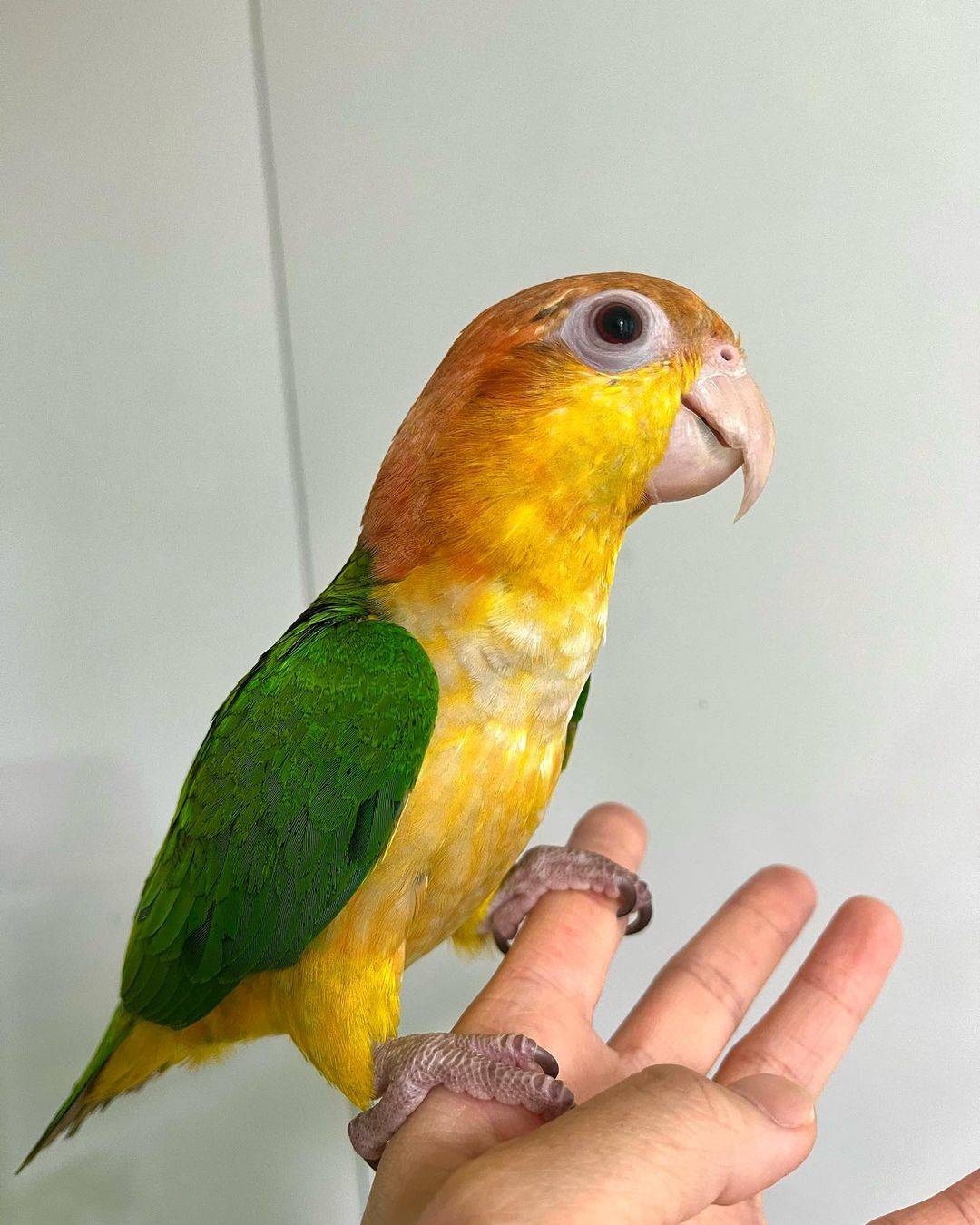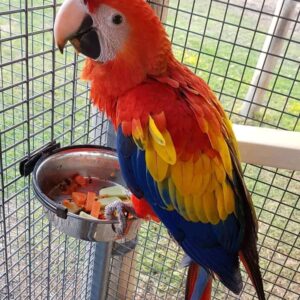Description
Baby White Bellied Caique in USA. The species Pionites leucogaster contains three subspecies including the nominate race, but recent morphological work suggests the species should be split into three. Caiques (pronounced kye-eeks or Kye-ee-kayes) belong to the psittacine genus Pionites. White-bellied caiques comprise three sub-species: Pionites leucogaster, P. l. xanthomeria, and P. l. xanthurus.
Mass: 5.5 oz (Adult)
Scientific name: Pionites leucogaster
Conservation status: Endangered (Population decreasing)
Higher classification: Caique
Order: Parrot
Caique ( or
[2]) refers to a group of four species of parrots in the genus
Pionites. The term “caique” in their official common name according to the IOU is replaced with “parrot”; however, “caique” is used by most persons and has been in use for at least 100 years (reference note). The term "caique" is primarily used in aviculture, with ornithologists typically referring to them as "White-bellied Parrot and Black-headed Parrot" to describe the nominal species. They have historically been called the “seven colored parrot”. They are relatively small and stocky, with a short, square tail and bright colors; this may be why they are referred to as “caique” based on the term for a similarly described Turkish vessel. The two primary nominal species are best distinguished by the black-headed caique’s black crown; both have white “bellies”. Their typical weight is 150–170 grams, with the white-bellied species being the larger and heavier of the two nominal species. They can live up to 40 years, but this is not common in captivity. Caiques are generally canopy dwellers, spending most of their time in the tops of trees, foraging and playing. Caique wing feathers produce a distinctive whirring sound in flight. They are highly vocal and can inflict severely damaging bites.
Taxonomy and systematics:
Originally
Pionites were classified as two species, the black-headed parrot and white-bellied parrot. However, recent morphological work has indicated that the white-bellied parrot should be split into three species based on plumage and leg coloration.
In the past these parrots were often allied with the conures or other South American parakeets. Recent mitochondrial and nuclear DNA work has found
Pionites to be the sister taxon to the
Deroptyus (the genus that contains the red-fan parrot); the two genera occupy a basal position in the tribe Arini.
| Pionites |
| Common name
(Binomial name)
Status |
Image |
Description |
Region and habitat |
| Green-thighed parrot
(Pionites leucogaster) |
|
About 23 cm (9.1 in) long. Mostly green and pink feet; apricot-orange cap; a medium, stout parrot. |
Amazon region of Brazil
Lives in lowland humid tropical and seasonally flooded forest. |
| Yellow-tailed parrot
(Pionites xanthurus) |
|
About 23 cm (9.1 in) long. Similar to the black-legged parrot, but yellow tail and pink feet. |
Amazon region of southern Brazil
Lives in lowland humid tropical and seasonally flooded forest. |
| Black-legged parrot
(Pionites xanthomerius) |
|
About 23 cm (9.1 in) long. Similar to the green-thighed parrot, but yellow-thighs and blackish feet. |
Parts of Bolivia, Peru and Brazil
Prefers seasonally flooded forest. |
| Black-headed parrot
(Pionites melanocephalus) |
|
About 23 cm (9.1 in) long. Mostly green, with yellow thighs with hints of orange; blackish feet; black cap with a black bill; a medium, chunky parrot. |
Parts of Colombia, Venezuela, the Guianas, Peru, and Brazil
Lives in lowland humid tropical and seasonally flooded forest. |
Aviculture

Caiques are increasingly popular in aviculture, particularly the black-headed caique, which was the first to be introduced into captivity. However, the white-bellied caique is quickly gaining popularity. These well-socialized caiques form strong bonds with humans and are known for their playful and lively nature, often engaging with toys and lying on their backs. An atypical behavior for birds is their tendency to roll onto their backs and engage in mock battles with other caiques, a behavior often referred to as "wrestling." Caiques are not adept flyers, becoming exhausted after a short flight and appearing clumsy and slow in the air compared to other birds. They show a preference for walking, jumping, climbing, hitching rides on the backs of other animals, or hopping. Their climbing skills are exceptional, supported by their robust feet and legs.
Caiques are known for a distinctive behavior termed "surfing," in which the bird energetically rubs its face, wings, and chest against any soft object nearby, such as carpets, towels, cushions, crumpled paper, curtains, or human hair. The bird uses its beak to propel itself forward, displaying jerky movements and occasionally rolling over. This action is believed to serve as a form of cleaning or bathing and is common among caiques of all ages and sexes. In their natural habitat, caiques perform this behavior using wet leaves.
In captivity, caiques can breed before reaching three years of age. They usually produce a clutch of four eggs, which incubate for 24 to 27 days. Raising all four chicks can be challenging for most pairs; the last chick to hatch may not survive unless it receives hand-rearing or co-parenting. Both parents feed the chicks, who stay in the nest box for about 70 to 75 days. The parents show great affection for their young, and even after the chicks have left the nest, they often return to roost with their parents in the nest box at night as a family unit.
Two species of caiques are commonly kept as pets: the black headed caique (
Pionites melanocephala) and the white bellied caique
(Pionites leucogaster).
Diet: The primary diet of a Caique should consist mainly of seeds, fruits, and green vegetables. Additionally, a commercially available parrot mix or pelleted diet can be advantageous.
Description: The Baby White Bellied Caique, a petite parrot, measures an average of 23 cm in length and weighs 165 g. Adorned with a vibrant orange cap, a luminous yellow chin, and a pure white breast, the white-bellied caique is undeniably one of the most vividly colored small parrots. Distinct color characteristics set apart the three subspecies of white-bellied caiques. While all possess white underparts, variations exist in the coloration of their tails and thighs. The P. l. xanthomeria, for instance, features yellow thighs and a green tail, with the back and wing feathers in dark green, complemented by deep blue wing coverts.
Range: White-bellied caiques are indigenous to Brazil, with populations also found in parts of Peru and Bolivia. They have a preference for lowland forests adjacent to waterways. These highly social birds often travel in pairs or small family units, subsisting on a diet of fruits, nuts, vegetation, and seeds from the rainforest. Similar to other parrot species, white-bellied caiques favor nesting in tree cavities situated high within the rainforest canopy. The female may lay two to four small white eggs, which she incubates for approximately 26 days, seldom leaving the nest. During this period, the male is responsible for foraging and feeding her. Once hatched, the chicks are altricial, requiring both parents to feed and nurture them until they are ready to fledge at around 14 weeks old, when they start to forage and feed independently.
Habitat: The white-bellied caique, along with numerous plant and animal species in the area, faces the threat of habitat reduction. Brazil's rainforests are being depleted rapidly, leading to a significant decline in various rainforest species. If this destruction persists, it will inevitably result in the extinction of many species.
Artificial Incubation of Baby White Bellied Caique: During the breeding season in Florida, which typically runs from January to June, nest boxes are inspected daily. By 0900 hours, eggs are collected and then weighed, measured for length and width, marked with details of species, date, and cage number, and placed into an avian incubator. This incubator is kept at 99.9°F with a humidity level of 50%. Chicks emerge on the 26th day of incubation. At birth, they are weighed, marked with non-toxic color codes, and settled into individual plastic cups padded with soft, absorbent cotton. The hatchlings are then moved to an avian brooder, which is set at 97°F with full humidity. As the chicks grow, the brooder temperature is gradually reduced, typically by three to five degrees at a time. When the chicks are fully feathered, the brooder is adjusted to the ambient room temperature.
Hand-feeding Baby White Bellied Caique: After hatching, white-bellied parrot chicks are fed every 90 minutes continuously for the initial five to seven days. They receive a commercial parrot hand-feeding formula, freshly prepared at each feeding. The formula is administered using syringes and warmed to 100-105°F. Early growth patterns show that a weight increase of 15-20% within a single day is a critical indicator of healthy development during the first week. Once this growth rate is reached, the chicks typically continue to gain weight at an approximate rate of 15% in the subsequent weeks. Post the initial week, the feeding interval extends to approximately every 2.5 hours or as soon as the crop empties. By four to five weeks of age, the feeding frequency is reduced to four times daily. Weaning starts around the tenth week, with complete weaning by the fourteenth week. During this phase, feedings decrease gradually, and the diet expands to include items like millet spray, bananas, soaked monkey biscuits, whole wheat bread, cooked rice, beans, pasta, and a full adult diet of seeds and fruits offered each day.









Reviews
There are no reviews yet.